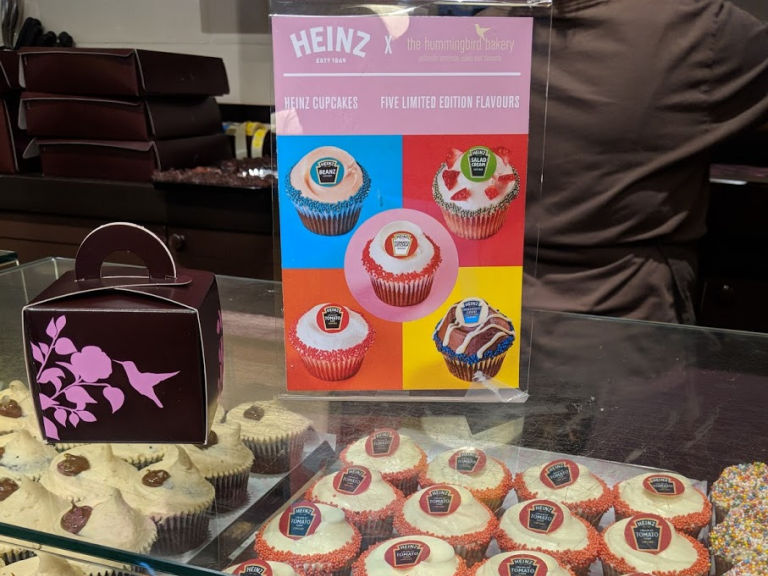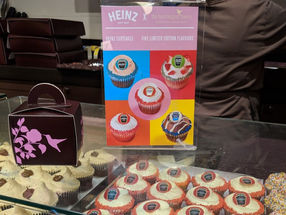Food adventures - November 2019
What Mintel analysts ate this month
In this series, Mintel analysts share their recent food adventures, highlighting the exciting, the delicious, the intriguing and the terrible food and drink they’ve tried lately. This month, they’ve discovered traditional dishes during their travels, and unexpected flavour combinations.

Heinz Tomato Soup cupcakes
Mintel

dry ice desserts
Mintel


The novelty of Heinz Tomato Soup cupcakes
Kate Vlietstra, Global Food & Drink Analyst – eaten in London
To celebrate its 150th birthday, Kraft Heinz has collaborated with London’s Hummingbird Bakery to create five limited edition cupcakes in tomato soup, tomato ketchup, salad cream, mayonnaise and baked beans flavours. I do love a Hummingbird Bakery cupcake – despite the excess icing that seems to be a prerequisite these days – and I was intrigued to try one of these novel flavours. The cupcake itself didn’t look particularly special, aside from the little edible logo wafer atop the basil-flavoured cream cheese frosting. The sponge was springy and moist, with a delicate hint of the classic Heinz tomato soup flavour. Despite being a fan of sweet-and-savoury combinations, this just didn’t do it for me. A savoury version, like a muffin, would have been delicious; it just doesn’t need the sweetness of a cupcake. It wasn’t unpleasant, but not something I’d be desperate to try again!
The dramatic theatre of dry ice desserts
Marcia Mogelonsky, Director of Insight, Mintel Food and Drink – eaten in Carmel, California
In fire-weary and fire-cautious California, it’s not surprising that enterprising chefs have found a sustainable and safe alternative to birthday candles. I recently ate at Billy Quon’s Sur at the Barnyard, a ‘rustic chic Californian cuisine’ restaurant in Carmel, and shared the Sur’s Arctic Ice Cream BonBons desserts with my dining companions. According to the menu, this dessert comprises Marianne’s French Vanilla ice cream, hand-scooped into three bonbons, dramatically served over dry ice, with accompanying dips of Ghirardelli chocolate and caramel sauces, chopped nuts and chocolate sprinkles. The dry ice makes it quite a dramatic dish and freezes the chocolate sauce into a crunchy hard shell, which provides a textural alternative to the soft ice cream and smooth caramel sauce. Overall, it was all a bit too much for me, but I can’t deny that it’s a fun concept! Who would have guessed that dry ice, a very retro concept, would make such a great alternative to candles, sparklers and other ‘special occasion’ dessert decorations?!
The layered taste of Mole Madre
Amanda Topper, Associate Director, Foodservice – eaten in Mexico
While on holiday in Mexico, I had the opportunity to dine at Pujol, which is the #12 best restaurant in the world, according to the World’s 50 Best Restaurants list. Pujol’s most famous dish is Mole Madre, Mole Nuevo, which comprises two types of housemade mole. The outer mole is the Mole Madre, or mother mole, that has been aged for five and a half years (or 2,028 days when I tried it). Like a sourdough starter, they take a little of the previous day’s mole and add it to the next batch. The dish is also served with the Mole Nuevo, or new mole, allowing you to compare the flavors of both. The mole is accompanied by homemade tortillas that have blue corn on one side and hoja santa (Mexican pepperleaf) on the other, further allowing you to mix and match flavors to your liking.
The environmental advantage of Sainsbury’s reusable produce bags
Amy Price, Senior Food & Drink Analyst – bought in London
I’m slightly cheating here, as this is not a dish, but it’s still an interesting food-related innovation! Sainsbury’s are looking to appeal to environmental shoppers by launching reusable bags for fresh produce. At 30p per bag, acting environmentally might make you feel good, but it will certainly cost you. Like when the plastic bag charge was introduced in 2015, I think the main challenge will be in making the produce bags reusable, ie reminding shoppers to actually bring them every time they go shopping. This will be especially hard, as I will probably use them to store my fresh produce in my fridge. The move follows Lidl’s introduction of similar bags at its stores, at a cost of 69p for two, and Morrisons’ introduction of paper bags for its fresh produce, although the latter met with some criticism on whether paper is always better. Overall, I like the initiative and I would buy the bags again (I’d probably NEED to, as I will surely always forget them!)
The satisfying texture of khao soi
Melanie Zanoza Bartelme, Global Food Analyst – eaten in Bangkok
During my travels in Bangkok, my lovely Thai coworkers introduced me to khao soi – a delicious part-soup, part-noodle curry. The dish consists of a layer of noodles on the bottom, topped with a chicken curry, finished with crunchy fried noodles on top. The contrasting textures worked so well together and made for a satisfying but not too heavy lunch. This was truly one of the best things I’ve eaten all year! As my next mission, I’m planning to scout local Thai places in Chicago, where I live, to try to recreate the experience.
The goaty taste of Kilawing Kambing
Trish Caddy, Senior Foodservice Analyst – eaten in London
Carcass Cartel is a meat-led initiative by UK chefs to champion nose-to-tail cooking, which uses every part of the animal. In October, I visited Native at Southwark, London, which hosted Carcass Cartel’s ‘Goatober’ supperclub. Goatober is the annual month-long goat meat food festival that aims to put all male goats born into the dairy system into the food system. It bridges the gap between farmers in the goat dairy supply chain, chefs and diners by promoting and putting tasty goat meat dishes on menus. The dish that stood out was Kilawing Kambing on a toasted rice tortilla, by Filipino chef Budgie Montoya. The roasted goat meat and skin, marinated in vinegar, is often served with boiled rice in Filipino cuisine. Instead, compressed rice shaped like a tortilla and lightly toasted was used to hold the meat together. A versatile base for strong flavours, the rice absorbed the goat drippings surprisingly well, releasing an intense ‘goaty’ smell. Nose-to-tail cooking encourages less waste and more thoughtfulness when it comes to the meat industry. I’d love to see all meat-led foodservice operators and meat-eaters alike embrace this more sustainable way of eating meat.
The syrupy sweetness of gulab jamun
David Luttenberger, Global Packaging Director – eaten in India
While visiting India during a packaging roadshow for clients, I tried one of the country’s classic desserts, gulab jamun. When I first saw these little balls, which were described as ‘baked cottage cheese’, I was a bit hesitant, but then I found out that they were coated and marinated in a thick, sweet syrup, and that sounded immediately better! The dessert is served warm, with extra syrup drizzled over it, and it’s actually delicious. I’d definitely eat it again and would recommend to anyone traveling in India!





























































